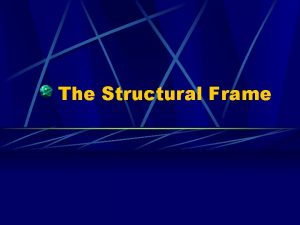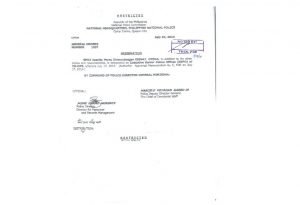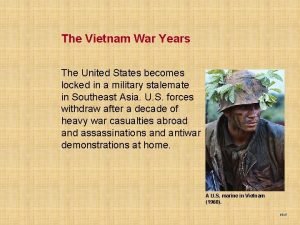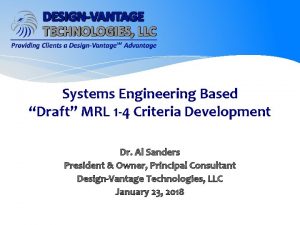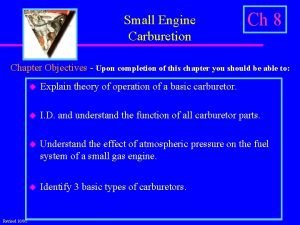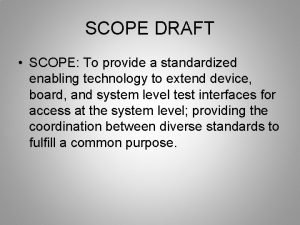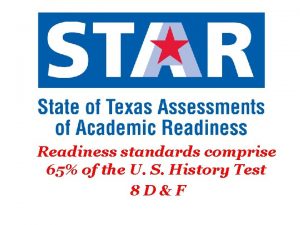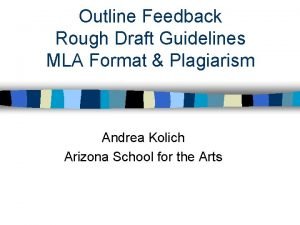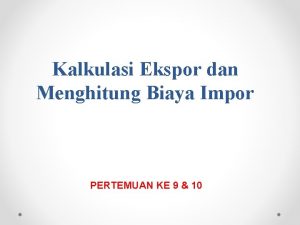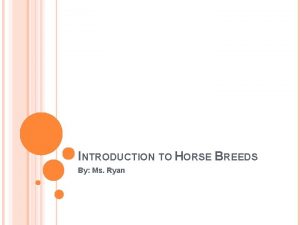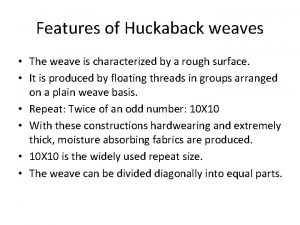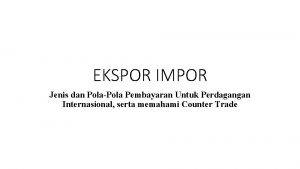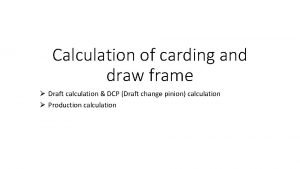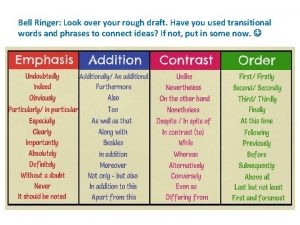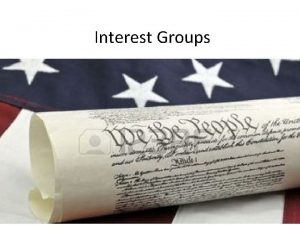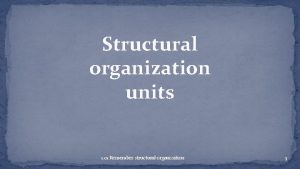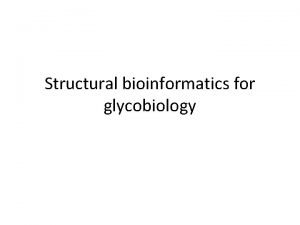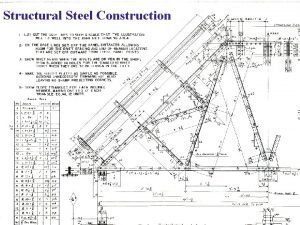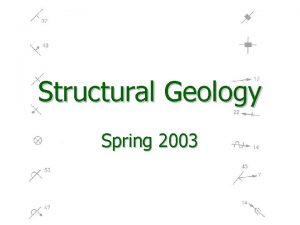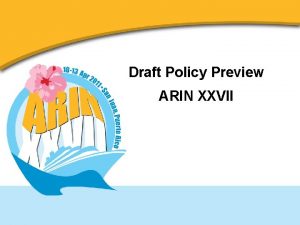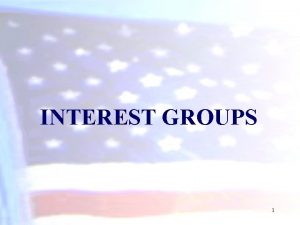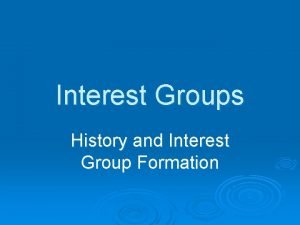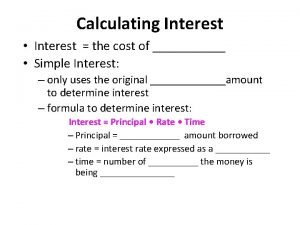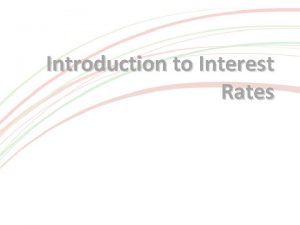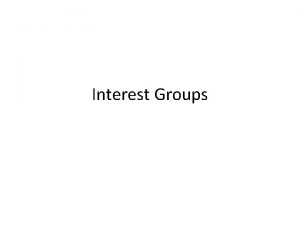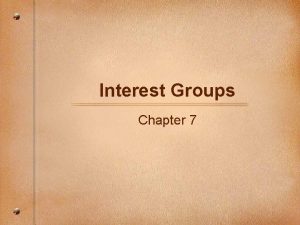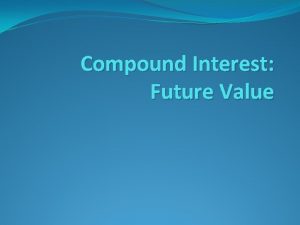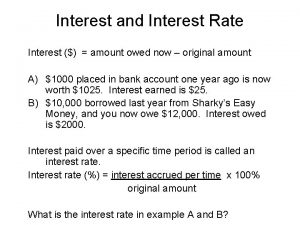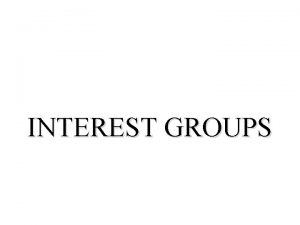Organization of Interest Important Concepts DRAFT Structural Organization





































- Slides: 37

Organization of Interest: Important Concepts DRAFT Structural Organization and Key Attributes January 28, 2010

Objectives § Overview of current approach § Outline needs § Propose working draft of new “Organization of Interest” approach to MSU internal organizations • Organizations • Relationships • Structures of Organizations and Relationships • Related Data Copyright © 2009 Michigan State University ebsp. msu. edu 1

Needs § Multi-level hierarchy capability § Non-hierarchical structures • To group organizations • To represent collaborations of various types § Explicit data attributes and relationships to capture various relationships and serve many purposes Copyright © 2009 Michigan State University ebsp. msu. edu 2

Needs, cont’d § Backward compatibility • Continue support for legacy systems that will remain after SAP/KFS go-live § Multiple types of structures, instances of structures • Example: Different hierarchy structures as needed to support different functions Copyright © 2009 Michigan State University ebsp. msu. edu 3

Basic Concept • Define the right organizational unit building blocks and use them to construct more complicated relationships and structures Copyright © 2009 Michigan State University ebsp. msu. edu 4

Organization § The basic building block § Can exist in order to be: • An individual organization (most detailed or granular piece) • A root for grouping of other organizations – Hierarchical or non-hierarchical Copyright © 2009 Michigan State University ebsp. msu. edu 5

Relationships § Needed in order to actually create groups, hierarchies, or other structures § If organizations are the boxes, relationships are like the arrows s ip nsh io lat e R § Can have different types of relationships Copyright © 2009 Michigan State University ebsp. msu. edu 6

Things We Want to Know About Organizations (Attributes) § Organization Identifier (Org ID, Org Code) § Organization Names § Organization Address Types • Locator Types § Organization Characteristics Copyright © 2009 Michigan State University ebsp. msu. edu 7

Other Things We Want To Know (Other Attributes) § Relationship Types § Structure Types (Hierarchical and Nonhierarchical) Copyright © 2009 Michigan State University ebsp. msu. edu 8

Organization Identifiers (Codes) • Legacy structure from conversion • Legacy organization (MAUs and departments) data will be converted with an 8 -digit identifier that has a coincidental initial resemblance to legacy code NOTE: Subsequent organization-reporting changes will not change the value of this identifier – it cannot be used to derive reporting relationships! • Future coding • After go-live, new organization IDs will be 8 -digit numeric with the first character being neither 1 nor 0 • There will be no “sight recognition” or meaning built into the code – just a number without inherent meaning

Organization Names § Organizations have multiple names § Planned Name Types: • Official – Complete name as approved by Board of Trustees or other appropriate entity. – Up to 255 characters • Full – Up to 40 characters – Legacy allows 43; OPB will shorten those over 40 before conversion • Short – Up to 18 characters – Supports legacy systems and other reporting uses Copyright © 2009 Michigan State University ebsp. msu. edu 10

Organization Addresses § § Organizations may have multiple addresses Each address has an address type Two legacy address types will be converted Planned address types: • PL – Primary Physical Location – Address where the organization is actually located • PD – Payroll Delivery – Address where payroll is delivered – Needs to be “deliverable” but may not be where the organization’s physical presence is – Example: Some extension organizations have payroll delivered on campus, but they are physically off campus Copyright © 2009 Michigan State University ebsp. msu. edu 11

Other Organization Locator Types § Organizations may have other “locator information” § Example locator types: • EM - Email • TL – Land-line telephone • TC - Cell phone • TF – Fax telephone • TP - Pager • UR – URL Copyright © 2009 Michigan State University ebsp. msu. edu 12

Organization Types: Overview § A way to categorize an organization to identify it • In terms of its relative hierarchical position, - or • As a type of non-hierarchical organization. § A specific organization will have one and only one type. Copyright © 2009 Michigan State University ebsp. msu. edu 13

What Are The Organization Types? § UV = University System Represents the totality of the organization (MSU) § CA = Campus Represents a unique instance of a university within a university system. – At this time MSU has ONLY ONE. – Not a physical location! – There can be multiple campuses in a given UV. Copyright © 2009 Michigan State University ebsp. msu. edu 14

What Are The Organization Types? (Cont’d) § VP = Vice President Represents the highest level of a campus’ organization. – Examples: Offices of the President; VP of Finance, Operations & Treasurer; Provost & VP for Academic Affairs; VP for University Advancement, etc. § MAU = Major Administrative Unit A grouping of the university’s units for administrative purposes. Copyright © 2009 Michigan State University ebsp. msu. edu 15

What Are The Organization Types? (Cont’d) § DP = Department Represents a department which may be composed of one or more units, each of which is also part of other MAUs. These usually have one administrator who oversees the operation of all of the units. § U 1 = Unit Part of an MAU whose existence is separately authorized at the central level. § U 2, U 3 = Unit Defined Represents a portion of a U 1 defined by the unit. – Must be defined at least as pairs as they must encompass the entirety of the U 1. Copyright © 2009 Michigan State University ebsp. msu. edu 16

Other Non-Hierarchical Organization Types § CL = Collaborative Represents a collaborative organization, composed of various units. – Designed to facilitate collaborative efforts across the University. – Example: Programs or services provided through collaboration of U 2 s within multiple U 1 s, but not formally constituted as institutes/centers or as U 1 s in and of themselves. § GR = Group Represents a grouping of units for some functional reporting purpose not expressed above. – Example: a grouping of the non-medical colleges Copyright © 2009 Michigan State University ebsp. msu. edu 17

Organization Characteristics & Codes Overview § A set of characteristics and related codes for the purpose of associating important attributes to the organization. § Each characteristic may have many characteristic codes related to it. § Certain characteristics allow associating several of its related codes to a single organization. § Certain characteristics are mandatory for every organization. Copyright © 2009 Michigan State University ebsp. msu. edu 18

What Are the Organization Characteristics and Their Codes? § Characteristic: Classification § Codes: – “MSU” – “Agency” § Mandatory: Yes § Multiple Allowed: No § Every organization at initiation will be either MSU or an agency § Agencies are those in MAU 95, 98, 99 in legacy system, not a full spectrum of external organizations § Agencies have a separate governance structure; MSU has some fiduciary responsibility for them Copyright © 2009 Michigan State University ebsp. msu. edu 19

Organization Characteristics and Their Codes (Cont’d) § Characteristic: Organization Attribute (OA) § Codes: • Institutes and Centers (IC) – Organizations defined as such based on university policy document – Usually have a start and end date • General University (GU) – Organizations whose purpose is to manage a specific general university operation whose funding is not tracked as part of some regular unit’s budget – Examples: scholarships, fringe benefits – Important enough that they are reported separately, tracked separately, and they have their own organization code § Mandatory: No (i. e. , may have none) § Multiple Allowed: Yes Copyright © 2009 Michigan State University ebsp. msu. edu 20

Organization Characteristics and Their Codes (Cont’d) § Characteristic: Chart Code (COA) § Codes: • Chart Code – Used to capture the Kuali Financial System (KFS) chart to which the organization belongs § Mandatory: No (i. e. , may have none) § Multiple Allowed: No Copyright © 2009 Michigan State University ebsp. msu. edu 21

Organization Characteristics and Their Codes § Characteristic: Organization Purpose (OP) § Codes: – HR – Hiring » Organization may have positions » SAP HR implementation proposed to disallow positions for organizations without “HR” – BU – Budgeting » Organization is included in central budgeting » KFS/Cognos budgeting proposed to disallow central budgets for organizations without “BU” § Mandatory: No § Multiple Allowed: Yes Copyright © 2009 Michigan State University ebsp. msu. edu 22

Re l at io ns h ip Relationships Between Organizations Re lat i on sh ip • An organization may have a relationship(s) to one or more other organizations • There can be different types of relationships • Business rules may constrain what relationships particular organizations can (or must) participate in Copyright © 2009 Michigan State University ebsp. msu. edu 23

Structures of Organizations and Relationships • A set of organizations with particular types of relationships may be designated as a structure type. • Some structure types take the form of a hierarchy. • In a hierarchy structure, organizations are increasingly specific parts of the whole as you move down the hierarchy • Think of a management reporting hierarchy, or a hierarchy for “rolling up” financial reporting totals to increasingly broad or general categories • Example: • • • A and B are part of (or report to) X Q, X, and K are part of Y By implication, A and B are part of Y. Copyright © 2009 Michigan State University ebsp. msu. edu 24

Structures of Organizations and Relationships, cont’d • A structure has a type • A specific structure type is designed to support a particular purpose or usage • An organization may participate in multiple structure types, both hierarchical and nonhierarchical • Business rules may constrain what kinds of organizations or relationships can (or must) participate in certain structure types Copyright © 2009 Michigan State University ebsp. msu. edu 25

Relationship Types for Hierarchy Structures § RP - “Reports To” • For SAP HR interface, translates to SAP code A 0002 § BR – “Bidding” • Organization groupings related to HR layoff/bumping rights for certain bargaining groups. SAP code AZ 01 • These are a set of specialized groups but not a full (single root node) hierarchy structure. § AR – “Additionally Reports To” • Needed for dotted-line type relationships commonly shown in printed org charts like those of OPB or internal audit Copyright © 2009 Michigan State University ebsp. msu. edu 26

Other Relationship Types (Non. Hierarchical) § CO - “Consists Of” • Associates organizations with a collaboration (organization type CL) or group (organization type GR) in which they participate § HS - “Historically Before/After” Copyright © 2009 Michigan State University ebsp. msu. edu 27

Structure Types § Routing (Workflow) • Budget Planning • KFS – Kuali Financial System • SAP - Personnel § Reporting • BI – Budget/Administrative – Lead College – Duplicate Copyright © 2009 Michigan State University ebsp. msu. edu 28

Structure Types § Other • Groups • Collaborative • “Phone Book” Structure § SAP • Bidding • Cost Center – Org Structure Code Copyright © 2009 Michigan State University ebsp. msu. edu 29

Org Structure Code (NOT Org Id) Org Reference Code identifies a unit and does not change (1 – 3 characters) Org Structure Code (15 characters) • Composed of org reference codes • Specific to a unit within an org structure • Same unit may have different org structure codes in different structures Example of 15 -character Org Structure Code “UCVMMDDD 1234567” UV – University System (Org Reference Code in position “U”) CA – Campus (Org Reference Code in position ‘C’) VP – Vice President and President (Org Reference Code in position ‘V’) MAU – Major Administrative Unit (Org Reference Code in position ‘MM’) DP – Department (Org Reference Code in position ‘DDD’) U 1 – 1 st unit level below a department (Org Reference Code in position ‘ 1’) U 2 – 2 nd unit level below a department (Org Reference Code in position ‘ 2’) U 3 – 3 rd unit level below a department (Org Reference Code in position ‘ 3’) U 4– 4 th unit level below a department (Org Reference Code in position ‘ 4”) U 5– 5 th unit level below a department (Org Reference Code in position ‘ 5”) U 6– 6 th unit level below a department (Org Reference Code in position ‘ 6”) U 7 – 7 th unit level below a department (Org Reference Code in position ‘ 7”)

BUDGET STRUCTURE CHM 22 PROVOST P COM DEAN 430 DEAN 1 P 22430100 1 RADIOLOGY 711 RADIOLOGY-CHM 1 P 22711200 2 MICROBIOLOGY 586 MICROBIOL-CHM 1 P 22586300 3 DEAN 624 DEAN 1 P 34624100 1 RADIOLOGY 711 RADIOLOGY-COM 1 P 34711100 1 MICROBIOLOGY 586 MICROBIOL-COM 1 P 34586200 2 DEAN 604 DEAN 1 P 32604100 1 MATHEMATICS 574 MATHEMATICS 1 P 32574100 1 MICROBIOL-CNS 1 P 32586100 1 34 CNS 32 MICROBIOLOGY Org Reference Codes: numbers outside of boxes Org Structure Codes: numbers inside of boxes 586

LEAD COLLEGE STRUCTURE CHM 22 430 DEAN 1 P 22430100 1 RADIOLOGY 711 RADIOLOGY-CHM 1 P 34711200 2 MICROBIOLOGY 586 MICROBIOL-CHM 1 P 32586300 3 624 DEAN 1 P 34624100 1 711 RADIOLOGY-COM 1 P 34711100 1 MICROBIOL-COM 1 P 32586200 2 604 DEAN 1 P 32604100 1 574 MATHEMATICS 1 P 32574100 1 586 MICROBIOL-CNS 1 P 32586100 1 DEAN PROVOST P COM RADIOLOGY 34 MICROBIOLOGY CNS 32 DEAN MATHEMATICS MICROBIOLOGY Org Reference Codes: numbers outside of boxes Org Structure Codes: numbers inside of boxes 586

§ § § Additional Information About Organizations, Relationships and Structures “Must Participate” business rules • Organization occurrences may be required to participate in certain mandatory structures. • This is a relationship between an organization and a structure type, indicating that organization is required to have one or more relationships in that structure type. • Established at the time the organization is created “Lead Org” attribute • In a given structure, a way to identify which of multiple peer organizations within a larger organization is responsible for the larger organization. • Example: The college dean’s office Structure Organization Name • An organization participating in a structure may need to have a structure-specific name in addition to its basic name • Objective is for reports to clearly indicate what structure has been used to produce rolled-up totals for an organization.

Additional Information About Organizations, Relationships and Structures, Cont’d § Organization User Types • Need to associate certain kinds of people with an organization in ways different from the HR reporting structure • Expect to convert one type from legacy system: – AD – Administrator • Other types under consideration: – SE – Security Administrator Copyright © 2009 Michigan State University ebsp. msu. edu 34

Backward Compatibility for Legacy Systems § Only organizations created within the D 03 structure type down to the equivalent of the current department level will be sent back to the D 03 system equivalent (unit-defined orgs of a lower level will not be available) § As needed to support this, new organizations created after go-live can have a legacy interface code for use in the D 03 scheme (not the same as their OOI organization identifier) § Legacy codes – both the 2 -character MAU and 3 -character department – may be alphanumeric § All legacy systems must be modified to accept alphanumeric common unit codes Copyright © 2009 Michigan State University ebsp. msu. edu 35

Questions? Thank You! Copyright © 2009 Michigan State University ebsp. msu. edu 36
 Heel and toe arrangement in carding
Heel and toe arrangement in carding Structural functionalism approach
Structural functionalism approach Nominal v. real interest rates
Nominal v. real interest rates Nominal rate of interest
Nominal rate of interest Simple and compound interest
Simple and compound interest Interest groups free rider problem
Interest groups free rider problem From most important to least important in writing
From most important to least important in writing From most important to least important in writing
From most important to least important in writing Least important to most important
Least important to most important Levels of structural organization
Levels of structural organization Uyusud
Uyusud The human body an orientation
The human body an orientation Pnp organizational structure pdf
Pnp organizational structure pdf Research paper requirements
Research paper requirements Rough draft organizer
Rough draft organizer Natural draft carburetor drawing
Natural draft carburetor drawing Sports rough draft
Sports rough draft 1971 draft lottery chart
1971 draft lottery chart Mrl draft
Mrl draft Small gas engines chapter 8 answers
Small gas engines chapter 8 answers Draft scope
Draft scope Elements of research
Elements of research Credibility gap
Credibility gap Function of a carburettor
Function of a carburettor Mla rough draft example
Mla rough draft example Key performance indicators sample format
Key performance indicators sample format Contoh perhitungan
Contoh perhitungan Draft horse organism classifications
Draft horse organism classifications Research paper rough draft example
Research paper rough draft example Tech draft
Tech draft Huckaback weave design
Huckaback weave design Pengertian countertrade
Pengertian countertrade Rationale of the study
Rationale of the study Content of portfolio
Content of portfolio Production formula of carding
Production formula of carding Counterclaim sentence starters
Counterclaim sentence starters Nfl swot analysis
Nfl swot analysis Exposure draft adalah
Exposure draft adalah










